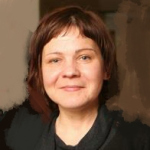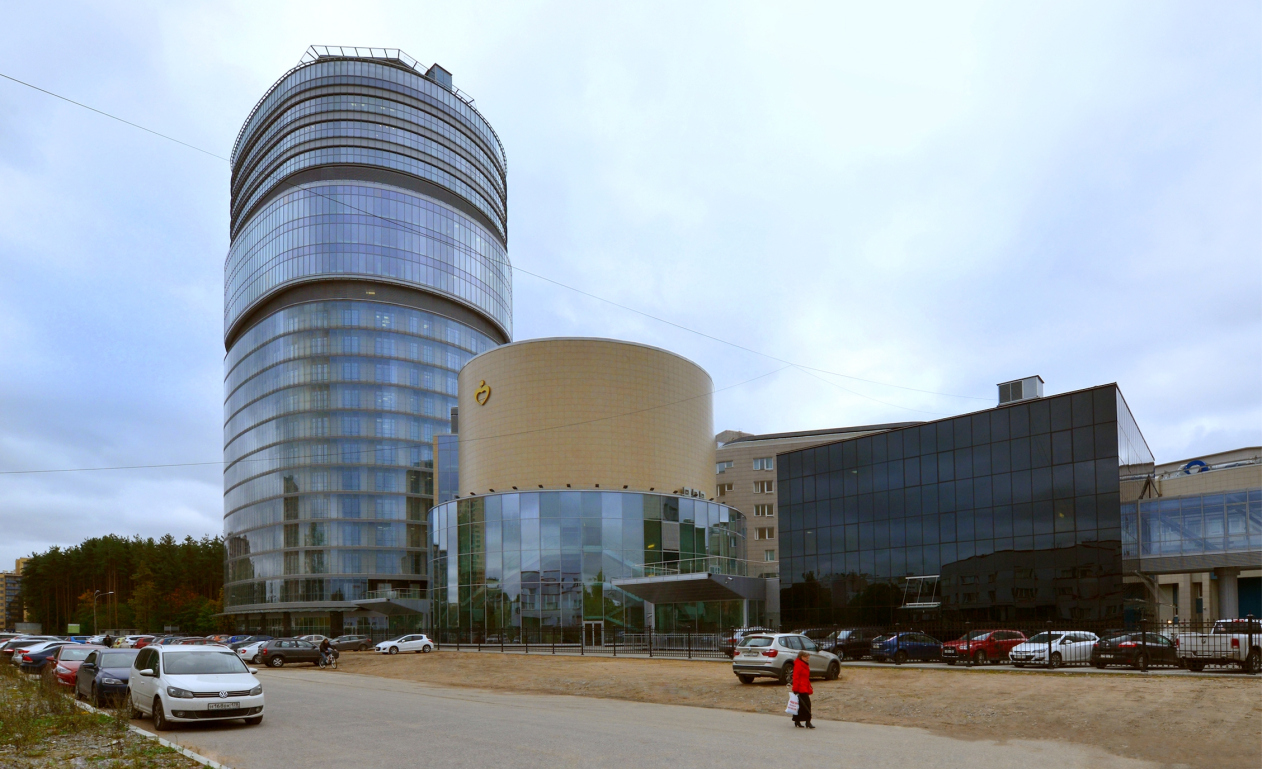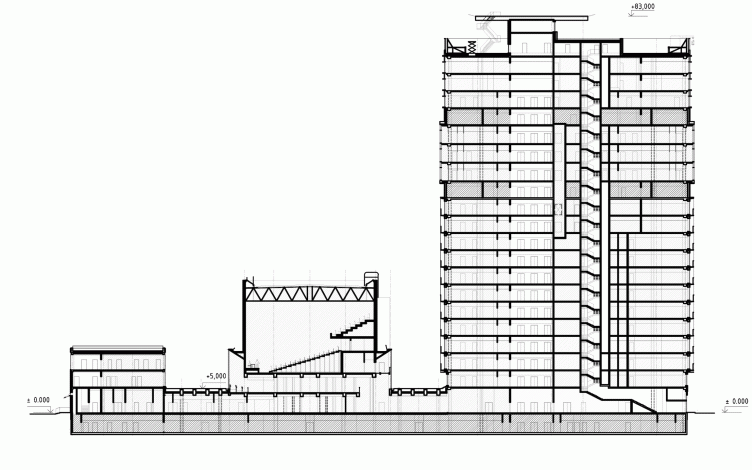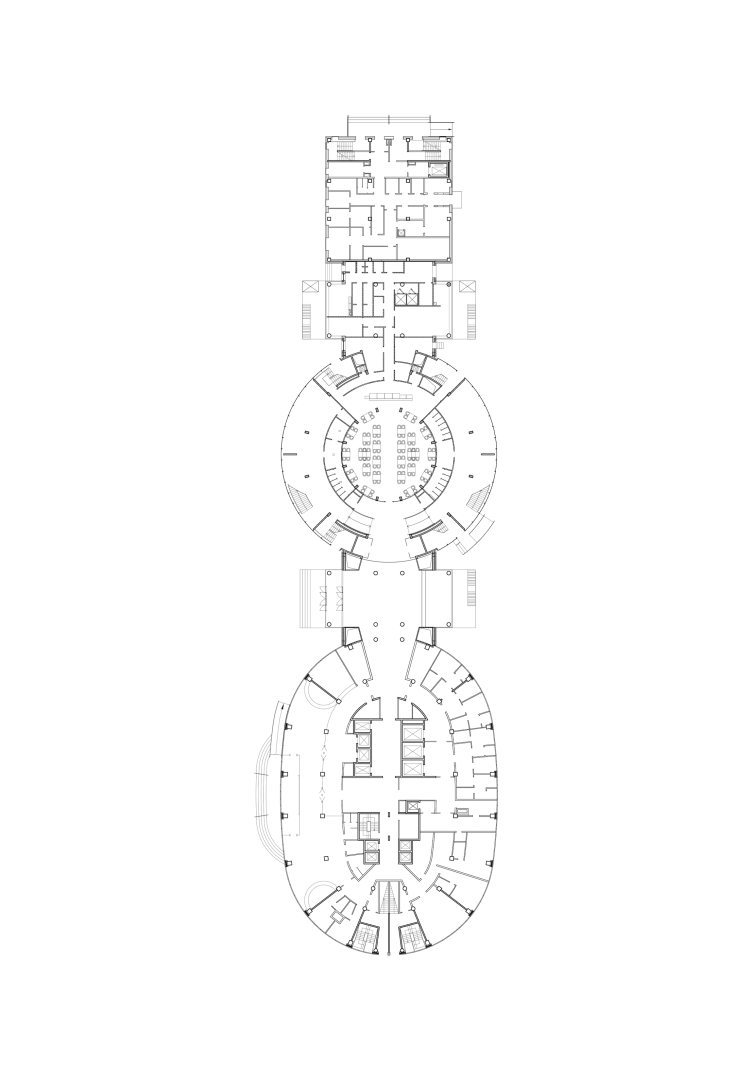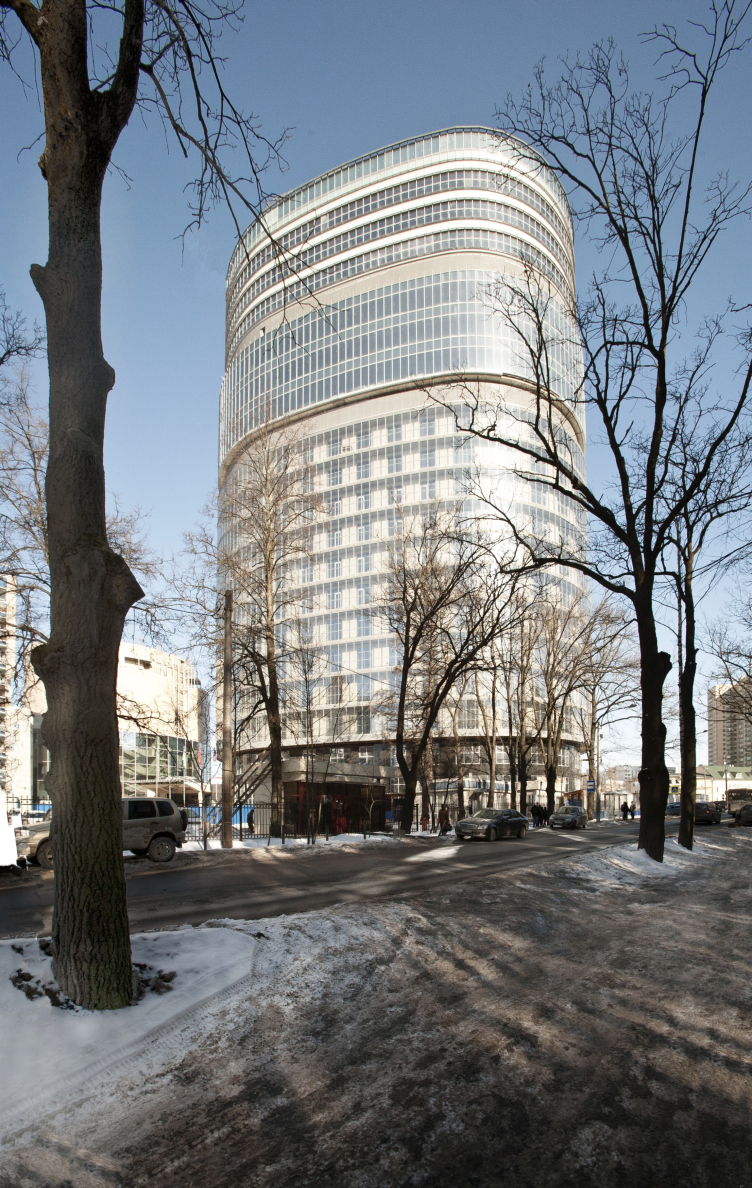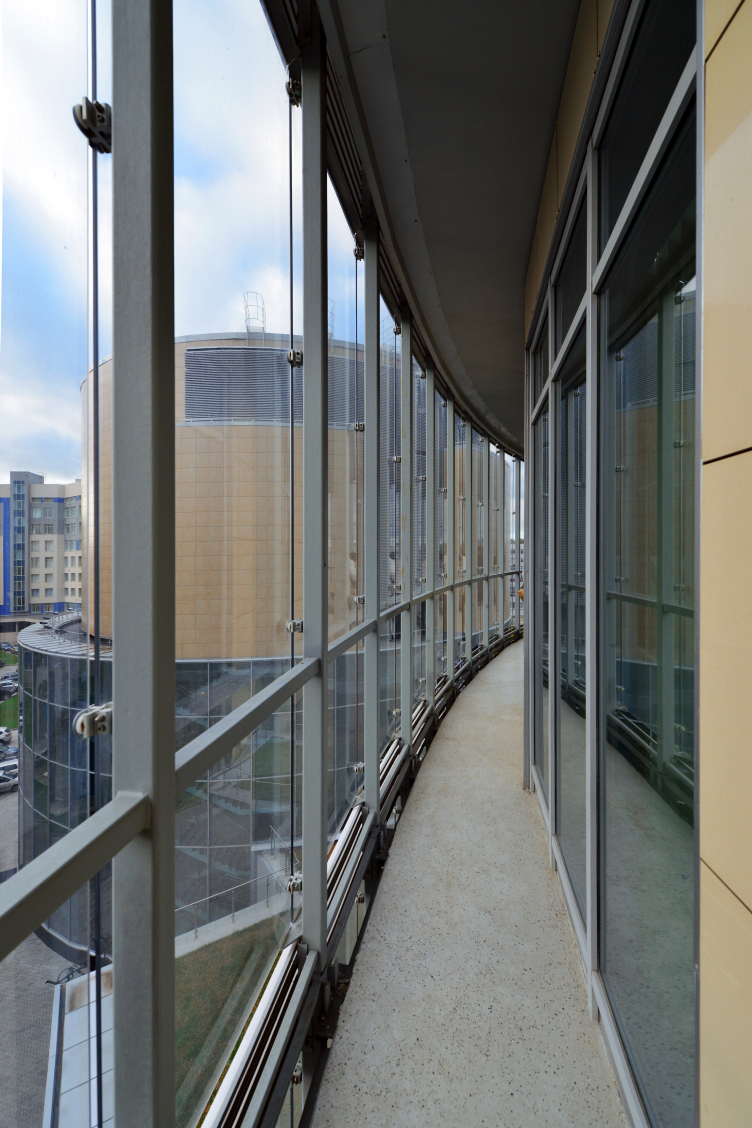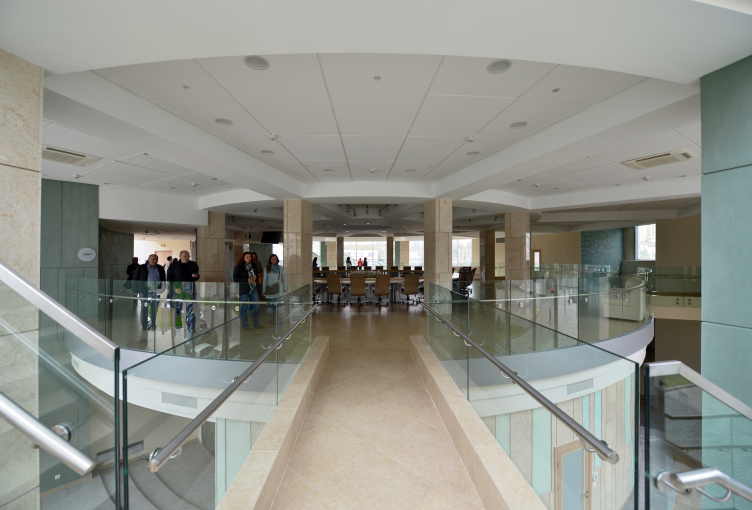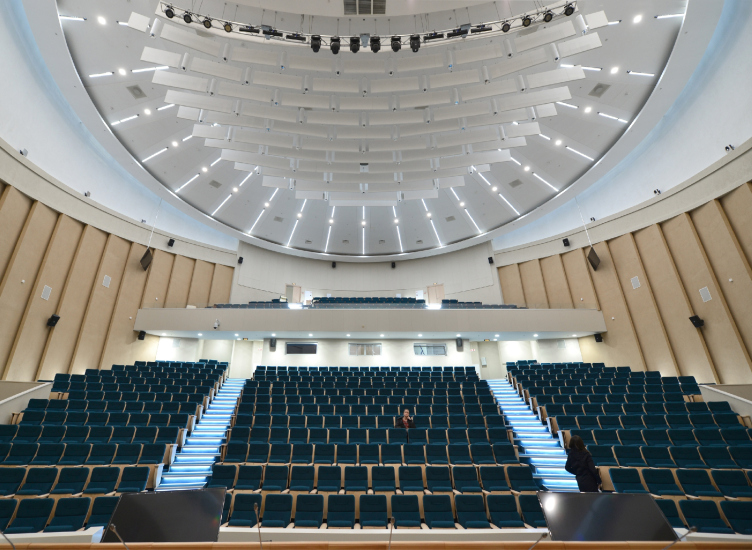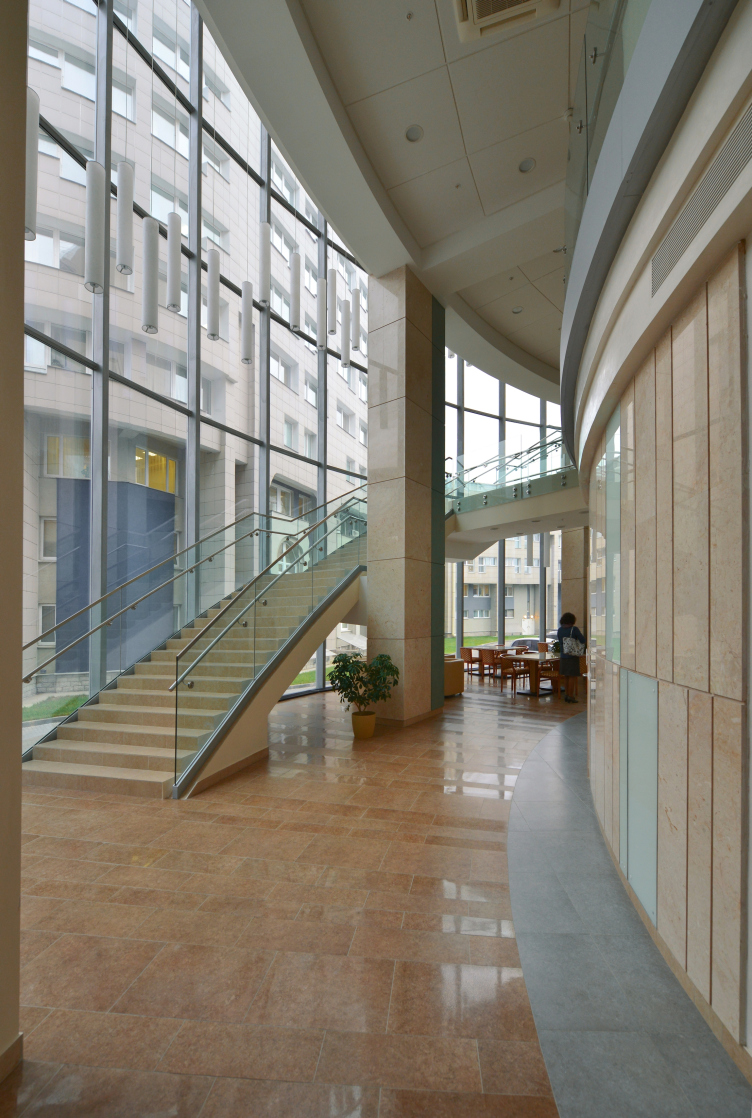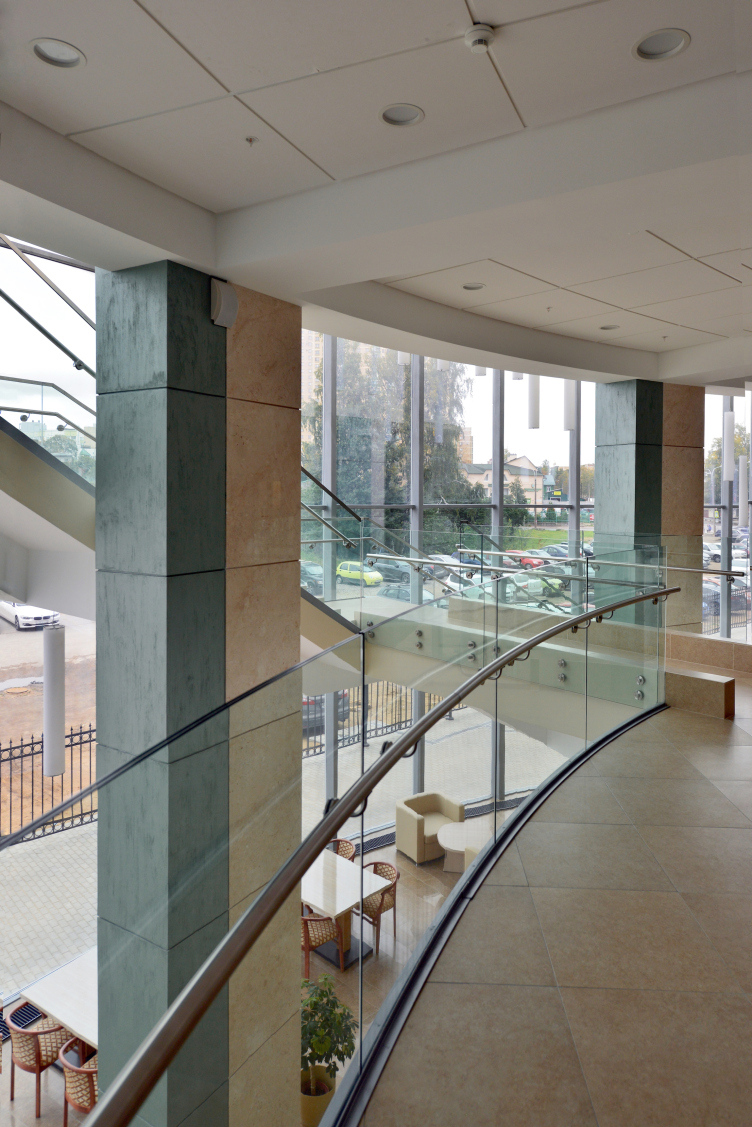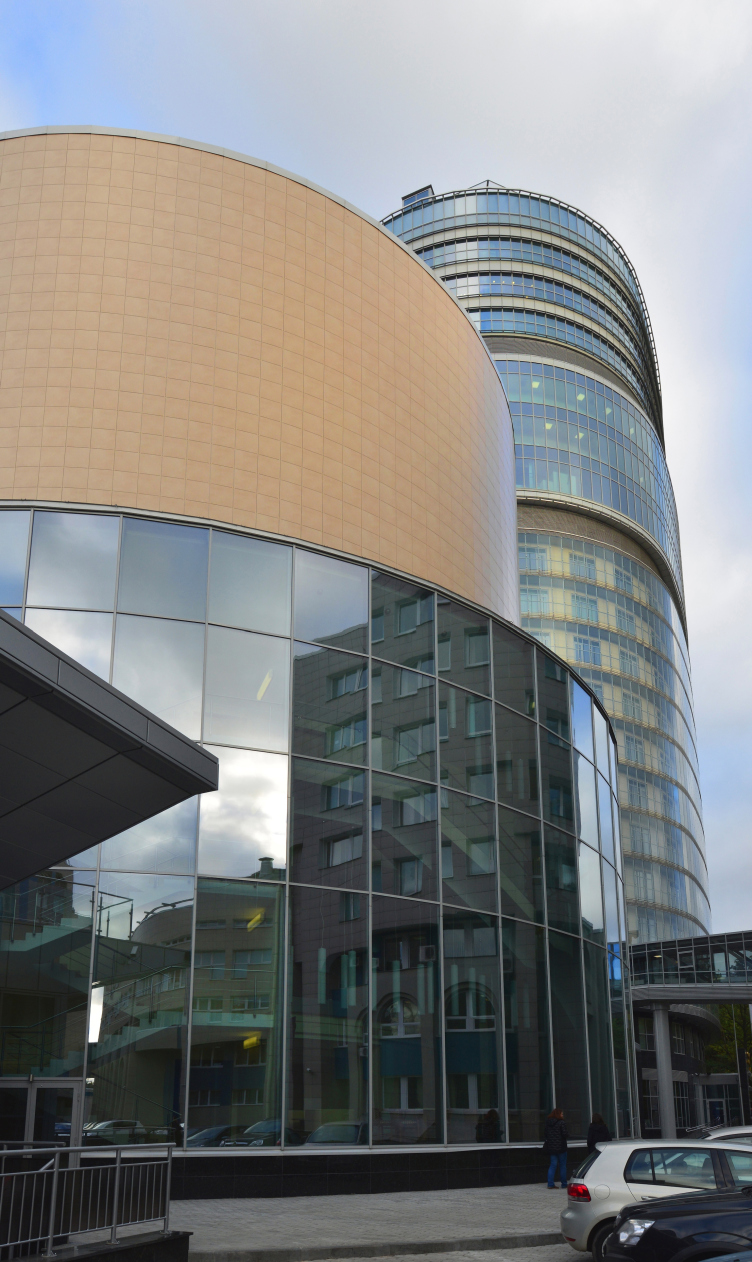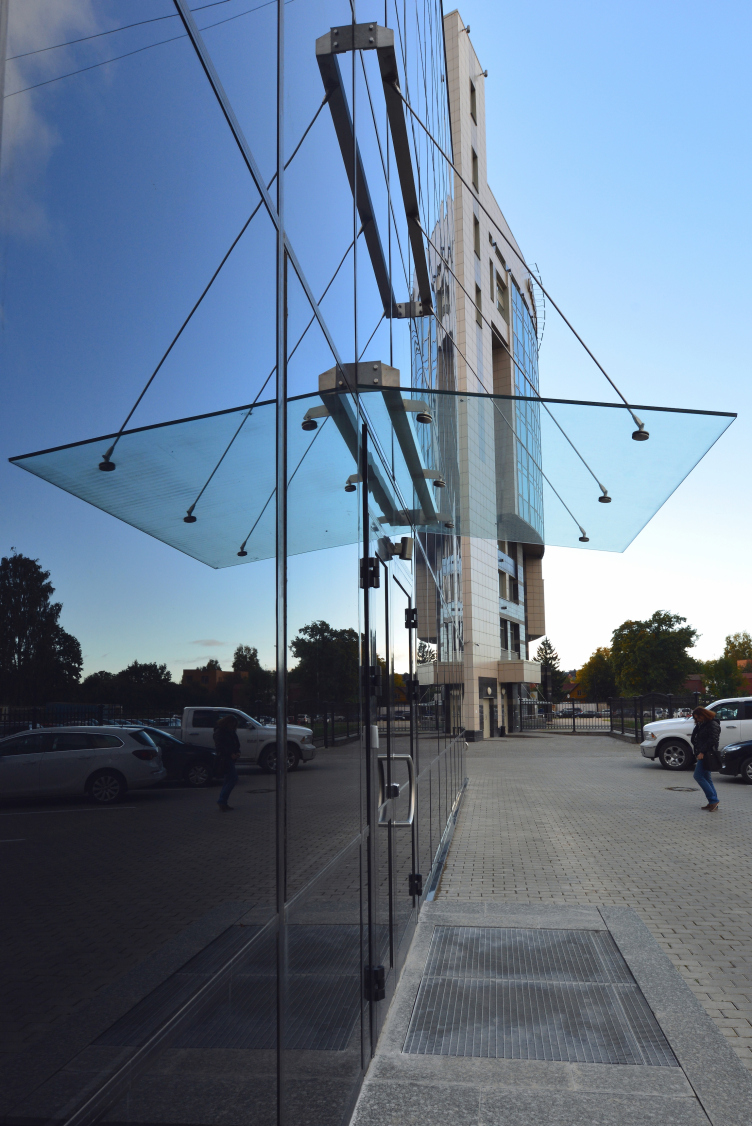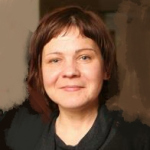The three new buildings, the construction of which was completed by Studio 44 in 2015, made an addition to the ensemble of medical complex, the building of which (in the former place of the Komendantsky airfield, north of the Udelny Park in the Primorsky district of Saint Petersburg) began with the government decree issued in mid-1980's. Originally, the medical center was a cardiological one, and later on it was granted a status of "Federal Center for Heart, Blood, and Endocrinology Research". This 1980's style building that occupies the central part of the territory in question was in the process of construction for more than fifteen years – from 1988 to 2006, with occasional hiatuses caused by lack of financing. Its intricate plan looks like a winged insect, while several of its volumes of different height alternate in a sophisticated fashion and are coated with ceramic granite – obviously, this was done at the close of the construction saga in late 2000's. Later on, in 2010, the north point of the trapeze got a curved volume of a perinatal center, strung on a circular tower.
The three buildings built by Studio 44 are meant for the major medical treatment facility. They stretch along the northeast border of the territory of the medical center that has now a status of a research one and beard the name of Vladimir Almazov. The new complex has only been allotted 3.6 hectares – which is a fifth of the territory that had already been densely packed with buildings by the moment the architects started the design work. Initially, the architects were required to design a building with a whopping height of one hundred meters, high-capacity, with wards enough to house three hundred patients, operating theaters, intensive care units, a diagnostic department, a cryogenic reservoir for umbilical blood, and, furthermore, a cafe for one hundred seats, and a conference hall for six hundred people. The first tender for designing this monster was won by a company that proposed to position the high-rise closer to the center of the territory, adjoining the main old building. Then the project was handed over to Studio 44 that made significant changes to the concept: calculations proved that it was impossible to position the tower at the place that was originally picked because this would violate insolation regulations. So it was shifted towards the eastern corner of the site. In addition, the architects of Studio 44 made an independent unit for the conference hall. Ultimately, what they got was two laconic volumes: an oval-plan hundred-meter-high tower and a round conference hall thirty meters high – on the one hand, they echo the rounded corners of the old building, and, on the other hand, they look integral, simple, and more laconic than their predecessors. An idea of adding a third unit – a black two-story cube that would house a cryogenic reservoir of umbilical blood and a department of high-technology diagnostics - came about later on down the line when the architects learned that, in order to function properly, the high-precision apparatuses would need to be isolated as much as possible from any vibrations or mechanical interference. As a result, along the red line of the Tbilisskaya Street, there appeared a chain of three simple geometric volumes: an oval, a cylinder, and a cube. Their height proportionately decreases: the cylinder's height is a little less than one third of the height of the hospital tower, and the cubic block is, respectively, half of the cylinder's height.
Treatment and rehabilitation facility "Federal Center for Heart, Blood, and Endocrinology Research named after Vladimir Almazov". Construction, 2015 © Studio 44
Treatment and rehabilitation facility "Federal Center for Heart, Blood, and Endocrinology Research named after Vladimir Almazov". Construction, 2015 © Studio 44
Copyright: © Studio 44
Treatment and rehabilitation facility "Federal Center for Heart, Blood, and Endocrinology Research named after Vladimir Almazov". Section view © Studio 44
Treatment and rehabilitation facility "Federal Center for Heart, Blood, and Endocrinology Research named after Vladimir Almazov". Plan © Studio 44
The starting point of the vertical zoning of the hospital tower was suggested to the architects by the fire safety regulations. Floors 1 to 12 contain wards for the patients – this is exactly the height of maximum reach of the rescue equipment that is available for a quick response time in this area of the city. Higher up, there are three floors with operating theaters and intensive care units – different evacuation rules apply for the hospital employees and immobile patients, hence, these premises can be placed at a greater height. Due to the fact that it is these specific floors that are most technologically advanced of all – they have lots of sophisticated equipment and antiseptic rooms in them – the thirteenth and the seventeenth floors perform the maintenance functions and include the climate and ventilation systems. This way, the intensive care and operating units are separated from the lower floors by tiers they are marked on the outside by stripes of yellowish ceramic granite. The two top floors – nineteenth and twentieth – are occupied by the administration offices and research laboratories. The roof had a helicopter landing upon it for evacuating and receiving the donor organs.
Treatment and rehabilitation facility "Federal Center for Heart, Blood, and Endocrinology Research named after Vladimir Almazov". Construction, 2015 © Studio 44
Treatment and rehabilitation facility "Federal Center for Heart, Blood, and Endocrinology Research named after Vladimir Almazov". Construction, 2015 © Studio 44
The second volume of the complex, occupied by a conference hall, consists in fact not of one but two cylinders: the two bottom floors are about eight meters wider than the upper ones, and this way the upper tiers get some sort of a "base" underneath them that includes an entrance lobby, a café, and bypassing corridors for entering the hall and going up on stage. The lower circle is made of glass, while the upper one is coated with yellow ceramic granite – the color is set by the first building of the medical center that is also of a somewhat yellowish color. The fact that the hall has blind façades is conditioned by its very function: should such need arise the hall can be lit by "clear-stories" or "roof-lights" that are curtain-covered during the movie screenings.
Treatment and rehabilitation facility "Federal Center for Heart, Blood, and Endocrinology Research named after Vladimir Almazov". Construction, 2015 © Studio 44
Treatment and rehabilitation facility "Federal Center for Heart, Blood, and Endocrinology Research named after Vladimir Almazov". Construction, 2015 © Studio 44
Treatment and rehabilitation facility "Federal Center for Heart, Blood, and Endocrinology Research named after Vladimir Almazov". Construction, 2015 © Studio 44
The volume of the hall rests on supports hidden inside the glass part, and this way the space underneath them is completely vacant – which increased the size of the café. One can get from the first floor up to the hall by two open-air staircases or by elevators. The roof of the entrance group that serves at the same time as a lintel between the middle and the third blocks is usable: it has green plants on it, it is accessible from the café, and one can through it to the third unit - but only in the warm seasons.
Treatment and rehabilitation facility "Federal Center for Heart, Blood, and Endocrinology Research named after Vladimir Almazov". Construction, 2015 © Studio 44
Treatment and rehabilitation facility "Federal Center for Heart, Blood, and Endocrinology Research named after Vladimir Almazov". Construction, 2015 © Studio 44
Treatment and rehabilitation facility "Federal Center for Heart, Blood, and Endocrinology Research named after Vladimir Almazov". Construction, 2015 © Studio 44
The third black cubic block obviously stands out against the background of all the buildings of the center, old and new alike. This way, there is an interesting game going on among the three buildings, a game of geometric forms of different matter and texture: the "black box" stands next to a stepping cylinder, part of it being glittering glass, and part being yellowish rock. This theme is picked up by the hundred meter tower of the hospital which is also two-layer and transparent, its surface being of a more complex nature: the double shell of the balconies of the hospital ward floors neighbor on the grilles of the maintenance floors and the ethereal glass of the operating rooms that lets in as much ambient light as possible.
Treatment and rehabilitation facility "Federal Center for Heart, Blood, and Endocrinology Research named after Vladimir Almazov". Construction, 2015 © Studio 44
The choice in favor of the high-rise tower of the first unit also appears as the optimum: from a compositional standpoint, the tower livens up the generally flat cityscape and sets the vertical this place has always been in need of. The three new blocks did fit in nicely with the already-dense ensemble of the complex. On the one hand, they are quite self-sufficient, modern, laconic, and clear-cut. On the other hand, they do not conflict at all with the old buildings of the center. Rather, what they do is they take the themes that these old buildings started and bring them to an imposing geometric absolute, almost megalithic, as is often the case with Nikita Yavein projects.
Treatment and rehabilitation facility "Federal Center for Heart, Blood, and Endocrinology Research named after Vladimir Almazov". Construction, 2015 © Studio 44
